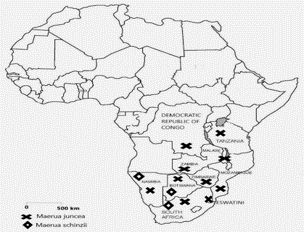Abstract
Maerua juncea Pax and M. schinzii Pax have a long history of medicinal use in southern Africa. This study aimed to review the ethnomedicinal uses, phytochemistry and pharmacological properties of the two species. Results of this study are based on data derived from several online databases such as Scopus, Google Scholar, PubMed and Science Direct, and pre-electronic sources such as scientific publications, books, dissertations, book chapters and journal articles. The leaves, roots, stems or whole plant parts of M. juncea and M. schinzii are mainly used as protective charm and tonic, and traditional medicines for fever, heart problems, headache, earache, skin disorders, fatigue and respiratory problems. This study showed that betaines and quaternary ammonium compounds such as 3-hydroxyprolinebetaine, proline betaine and 3-hydroxy-1,1-dimethyl pyrrolidinium had been identified from the aerial parts of M. juncea. In contrast, alkaloids, bitter principles, coumarins, flavonoids, saponins and terpenes have been identified from the leaves of M. schinzii. The leaf extracts and compounds isolated from the species exhibited antibacterial, antifungal, anti-HIV and cytotoxicity activities. There is a need for extensive phytochemical, pharmacological and toxicological studies of crude extracts of M. juncea and M. schinzii to establish the safety profiles of different preparations of the two species.
Full text article
Authors

This work is licensed under a Creative Commons Attribution-NonCommercial-NoDerivatives 4.0 International License.

